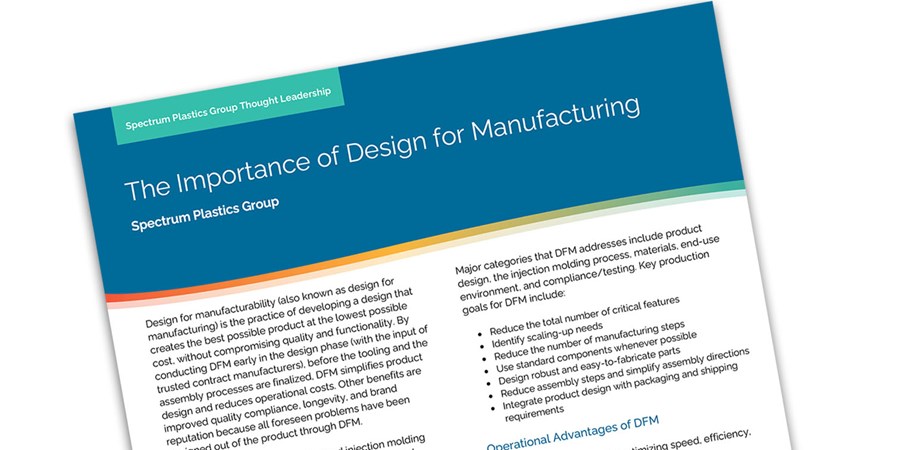The Importance of Design for Manufacturing

The Importance of Design for Manufacturing

Click here to download the thought leadership.
Design for manufacturability (also known as design for manufacturing) is the practice of developing a design that creates the best possible product at the lowest possible cost, without compromising quality and functionality. By conducting DFM early in the design phase (with the input of trusted contract manufacturers), before the tooling and the assembly processes are finalized, DFM simplifies product design and reduces operational costs. Other benefits are improved quality compliance, longevity, and brand reputation because all foreseen problems have been designed out of the product through DFM.
DFM determines the best design and injection molding process, and the easiest assembly, for the proposed product. A key part of DFM is selecting the type and form of raw material, dimensional tolerances, and any required secondary processes. A large number of available plastics and their diverse chemical and mechanical properties make material discussions during DFM critically important. Material selection impacts the performance, appearance, and longevity of the final product, as well as production cost.
When done correctly, DFM for injection molding will identify potential problems in the design that can then be fixed relatively easily, and at a low cost, during the design phase. With the increasing number of complex and miniaturized designs, injection molders must invest in the latest technologies such as robotics, automation, digital simulation and modeling, rapid prototyping, and design process software. Other Internet of Things technologies, especially sensors and artificial intelligence, are essential for using scientific molding.
Major categories that DFM addresses include product design, the injection molding process, materials, end-use environment, and compliance/testing. Key production goals for DFM include:
DFM is an essential step for optimizing speed, efficiency, and high rates of production.
At Spectrum, DFM begins as early as the quoting activity. When a customer presents a preliminary concept, our cross-functional engineering team evaluates the application, process, manufacturing, project, quality, and metrology. Is the part design moldable? Are there any risk areas for part design? Answers to these questions help determine the best plan for building the tool to produce this product. We also review any dimensions with tight tolerances, take into consideration any tool costs and budget constraints, and look at scalability options for manufacturing the volumes the customer is projecting.
The DFM process varies according to the complexity of the product design, material selection and performance, and the end-use environment. In general, about 75% of the total manufacturing cost for a product result from early design decisions, which makes DFM even more important for reducing costs. DFM is also a highly effective lean tool for eliminating waste and improving efficiencies in the value stream, often by reducing the number of parts, the need for secondary processing, and assembly complexity.
Other operational advantages of DFM are:
Also, important to consider during DFM are Design for Inspection (DFI) and Design for Assembly (DFA).
As medical devices and other high-technology products become smaller and more complex, and built from advanced materials, injection molders must have the latest tools to evaluate these more challenging design requirements. Injection molders depend on three key tools in the DFM process: finite element analysis, rapid prototyping, and scientific molding.
Surface finishes for plastic injection-molded components should be seriously considered during DFM and not be an afterthought. Conversations about desired aesthetic and performance characteristics of the finish will impact the type of material selected, additives required, and other parameters such as fill rate and pressure and temperature tolerances. Material options for the best surface finish depend on part design and the chemical make-up of the material used. Choosing the right material will have a significant impact on the final finish, especially if a glossy finish is desired.
DFM is an essential process for enhancing the manufacturability, quality, and durability of components and products while reducing waste and overall costs. Spectrum Plastic Group works closely with MDMs as a trusted technology and material advisor and injection molder to develop and manufacture their most innovative and complex products.
Contact us to learn how we can help you meet or exceed your goals for your next injection-molding project.